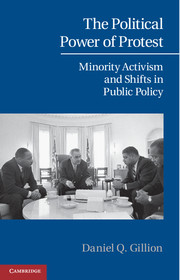Book contents
- Frontmatter
- Contents
- List of Figures
- List of Tables
- Preface
- Acknowledgments
- Introduction
- 1 A Continuum of Information
- 2 Measuring Information in Minority Protest
- 3 Viewing Minority Protest from the Hill
- 4 Knocking on the President’s Door
- 5 Appealing to an Unlikely Branch
- Conclusion
- Appendix A Defining Minority Political Protest
- Appendix B Study Description and Coding Across Multiple Institutions
- Appendix C Time Series Methods
- References
- Index
Appendix B - Study Description and Coding Across Multiple Institutions
Published online by Cambridge University Press: 05 February 2013
- Frontmatter
- Contents
- List of Figures
- List of Tables
- Preface
- Acknowledgments
- Introduction
- 1 A Continuum of Information
- 2 Measuring Information in Minority Protest
- 3 Viewing Minority Protest from the Hill
- 4 Knocking on the President’s Door
- 5 Appealing to an Unlikely Branch
- Conclusion
- Appendix A Defining Minority Political Protest
- Appendix B Study Description and Coding Across Multiple Institutions
- Appendix C Time Series Methods
- References
- Index
Summary
I use a variety of sources to understand a collective response from national government. A description of the variables used for each institution is described below. Measures of public opinion and the civil rights movement are constantly included in the analysis of each institution. Thus, I begin with these universal variables.
Public Opinion: Using the Gallup’s Most Important Problem series, I code the percentage of respondents who felt that racial and ethnic minority concerns were the most important problems facing the nation. This is used as a thermometer to gauge the relevance of racial issues.
Civil Rights Movement: The civil rights movement is dated from 1960 to 1968. Naturally, there are events that took place in the 1950s, a time period I believe to be a part of the civil rights movement, that are not included in this study. The use of 1960 is simply a byproduct of the available data on political protest. The year 1968 is selected as the end of this period because it coincides with the death of Dr. Martin Luther King Jr., which fragmented the movement. Moreover, this year is often considered to have signaled the decline of movement activism (see Lawson and Payne 1998).
Information
- Type
- Chapter
- Information
- The Political Power of ProtestMinority Activism and Shifts in Public Policy, pp. 165 - 170Publisher: Cambridge University PressPrint publication year: 2013
